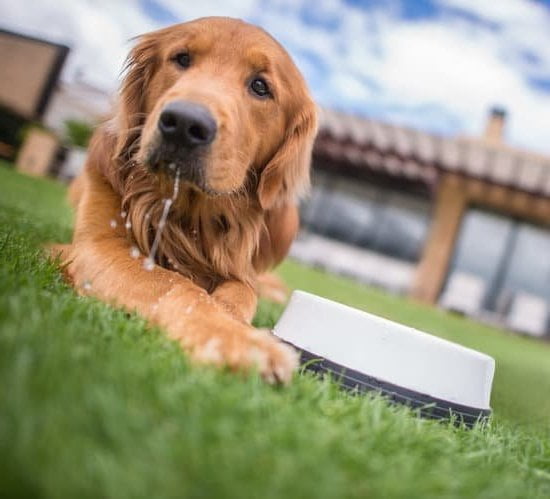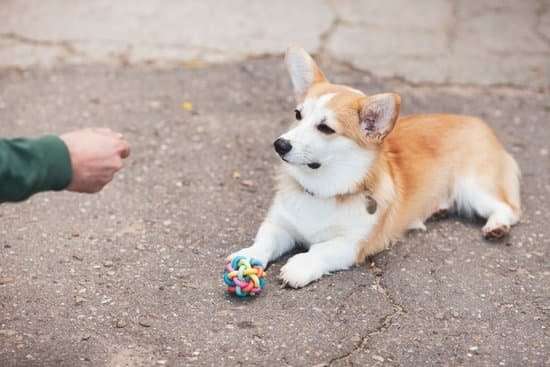Are you looking for a fun and engaging way to bond with your furry friend while keeping them physically and mentally stimulated? In this article, we will explore the exciting world of frisbee training for dogs.
From understanding the benefits of this activity to tips for choosing the right frisbee and step-by-step guides for training, we’ve got you covered. So, if you’re wondering how to train your dog frisbee, look no further as we delve into the wonderful world of canine frisbee training.
Frisbee training offers numerous benefits for dogs, including physical exercise, mental stimulation, and an opportunity for bonding with their owners. Whether you have a high-energy breed or a more laid-back pup, frisbee training can cater to a variety of needs and personalities. Additionally, this activity can help improve obedience and agility in dogs while providing them with an outlet for their natural instincts.
In this section, we will start by discussing the various benefits of frisbee training for dogs before delving into the specifics of how to get started. From choosing the right frisbee to building a strong foundation with basic commands and obedience, we will provide you with comprehensive insights on how to embark on this exciting journey with your canine companion. So grab your frisbee and let’s get started.
Choosing the Right Frisbee for Your Dog
When it comes to training your dog in frisbee, every aspect of the game is important, and that includes choosing the right frisbee for your furry friend. The material, size, and durability of the frisbee all play a crucial role in ensuring a successful and enjoyable experience for both you and your pet.
First and foremost, it’s essential to select a frisbee that is specifically designed for dogs. These frisbees are typically made of durable rubber or plastic that can withstand chewing and biting without breaking into small, sharp pieces that could harm your dog.
Additionally, it’s important to choose a size that is appropriate for your dog’s breed and mouth size. A frisbee that is too large or heavy may be uncomfortable for smaller dogs, while a small frisbee may pose a choking hazard for larger dogs.
Durability is another key factor to consider when selecting a frisbee for your dog. Look for options that are sturdy enough to handle repeated use without easily deteriorating. Some frisbees are designed to float on water, which can add an extra element of fun to your training sessions if you enjoy playing with your dog at the beach or near bodies of water.
Taking these factors into account will help ensure that you choose a frisbee that is safe and suitable for your dog’s abilities, ultimately enhancing the experience of training your dog in frisbee.
| Aspect | Consideration |
|---|---|
| Material | Durable rubber or plastic |
| Size | Appropriate for dog’s breed and mouth size |
| Durability | Sturdy enough to handle repeated use |
| Floating Abilities | Floats on water (optional) |
Pre-Training
Understanding the Importance of Pre-Training
Before diving into the exciting world of frisbee training with your dog, it is crucial to establish a solid foundation of basic commands and obedience. Pre-training plays a vital role in ensuring that your dog is mentally and physically prepared for the challenges and excitement of frisbee training. It also sets the stage for effective communication between you and your furry companion, laying the groundwork for a successful frisbee training experience.
Basic Commands and Obedience Training
The first step in pre-training for frisbee involves teaching your dog basic commands such as “sit,” “stay,” “come,” and “drop it.” These commands are essential for frisbee training as they provide you with control over your dog during playtime, allowing you to maintain safety and create a more enjoyable experience for both of you. Obedience training also helps in reinforcing discipline, respect, and focus, which are all valuable traits when engaging in any form of dog sports like frisbee.
Incorporating Playfulness Into Training
While building a strong foundation with basic commands and obedience is important, it’s equally crucial to incorporate playfulness into the pre-training process. Make learning fun by using positive reinforcement techniques, such as treats or toys, to reward your dog for following commands correctly.
By creating a positive association with training, your dog will be more enthusiastic about learning new skills, including how to train your dog frisbee. Incorporating playfulness will not only enhance the bond between you and your dog but also make the entire training experience more enjoyable.
Teaching Your Dog to Catch the Frisbee
Training your dog to catch a frisbee can be an enjoyable and rewarding experience for both you and your furry friend. It promotes physical activity, mental stimulation, and strengthens the bond between you and your pet. Whether you have a young puppy or an older dog, teaching them to catch a frisbee is a great way to engage in interactive play and provide an outlet for their energy.
To get started on training your dog to catch a frisbee, follow these step-by-step tips:
1. Start with the basics: Before introducing the frisbee, ensure that your dog has mastered fundamental commands such as “sit,” “stay,” and “come.” This will establish a strong foundation for frisbee training and make it easier for them to understand new instructions.
2. Introduce the frisbee: Begin by familiarizing your dog with the frisbee. Allow them to sniff it, touch it, and become comfortable with its presence. You can also use positive reinforcement techniques such as treats or praise to create a positive association with the frisbee.
3. Teach your dog to catch: When your dog is comfortable with the frisbee, start by tossing it at a short distance. Encourage them to chase after it and retrieve it. Gradually increase the distance of your throws as your dog becomes more confident in catching the frisbee.
Remember that patience and consistency are key when training your dog to catch a frisbee. Celebrate their progress and maintain a positive attitude throughout the process. With time and practice, you’ll soon be enjoying exciting games of fetch with your canine companion.
Perfecting the Throw
As you progress in training your dog to play frisbee, it’s important to focus on improving your frisbee skills as well. A good throw is essential for keeping the game fun and challenging for your dog. The better your throw, the more engaged and excited your dog will be during playtime. Here are some tips for perfecting your throw and enhancing the frisbee training experience for both you and your furry friend.
First, pay attention to your grip on the frisbee. Hold it between your thumb and fingers, making sure to keep a firm but not overly tight grip. The best way to grip a frisbee is with your pointer finger along the rim of the disc while using your thumb on top for control. This will give you better accuracy and distance in your throws, allowing for more dynamic play with your dog.
Next, focus on your throwing technique. Proper form is crucial for an effective throw when training your dog with a frisbee. Start by facing sideways to where you want to throw and use a smooth motion from back to front as you release the frisbee. Your body should work together with your arm and wrist to generate power and spin in the throw, which will make it easier for your dog to predict its flight path.
Finally, experiment with different types of throws to challenge and engage your dog during training sessions. Try practicing backhand throws, sidearm throws, or overhand flicks to vary the speed and direction of the frisbee. This will help keep things interesting for both you and your pup, ensuring that training sessions remain exciting and enjoyable.
| Tips | Improving Your Frisbee Skills |
|---|---|
| Paying attention to grip | Holding it between thumb and fingers |
| Focusing on throwing technique | Using a smooth motion from back to front |
| Experimenting with different types of throws | Practicing backhand throws, sidearm throws, or overhand flicks |
Advanced Frisbee Training
Increasing Distance
Once your dog has mastered the basic catching and retrieving skills, it’s time to work on increasing the distance of your throws. Start by throwing the frisbee a little farther each time, gradually building up to longer distances as your dog becomes more confident. Use positive reinforcement and treats to encourage your dog to run farther and retrieve the frisbee with enthusiasm.
Improving Accuracy
Accuracy is an important aspect of advanced frisbee training. Practice throwing the frisbee with precision, aiming for specific targets or challenging your dog to make acrobatic catches. Experiment with different throwing techniques, such as backhand or sidearm throws, to keep things interesting for both you and your furry friend.
Enhancing Agility
Incorporating agility exercises into your frisbee training can take your dog’s skills to the next level. Set up obstacle courses or use agility equipment like tunnels, hurdles, and weave poles to improve your dog’s speed, coordination, and dexterity while playing frisbee. These activities can also help prevent boredom and provide mental stimulation for active breeds.
With consistent practice and positive reinforcement, you can continuously challenge and engage your dog in advanced frisbee training. Remember that every dog learns at their own pace, so be patient and celebrate each milestone along the way. By incorporating distance, accuracy, and agility into your frisbee training routine, you can further strengthen the bond with your furry companion while keeping them healthy, happy, and active.
Troubleshooting Common Training Challenges
Training your dog to play frisbee can be a fun and rewarding activity, but it comes with its own set of challenges. As with any type of training, there will be obstacles and setbacks along the way. It’s important to be patient and persistent as you work through these challenges with your canine companion.
One common challenge in frisbee training is getting your dog to consistently catch the frisbee. Some dogs may have a natural inclination to chase after the frisbee, but actually catching it in their mouth can take time and practice.
If your dog is struggling with this skill, consider using a softer or lighter frisbee that is easier for them to grasp. Additionally, using positive reinforcement such as treats or praise when they successfully catch the frisbee can help motivate them to keep trying.
Another common challenge is getting your dog to bring the frisbee back to you after they’ve caught it. Some dogs may be more inclined to run off and chew on the frisbee rather than returning it to you. To overcome this challenge, start by teaching your dog a strong “drop it” or “release” command. Use high-value treats or toys as a reward when they bring the frisbee back to you, reinforcing the desired behavior.
It’s also important to address any fear or anxiety that your dog may have related to the frisbee. Some dogs may find the spinning motion of the frisbee intimidating, while others may be nervous about jumping or reaching for it in mid-air.
Patience, positive reinforcement, and gradual desensitization can help alleviate these fears and build confidence in your dog’s frisbee skills. Remember that every dog is different, so take the time to understand your dog’s unique challenges and tailor your training approach accordingly.
Safety First
Training your dog to play frisbee can be a fun and rewarding activity for both you and your furry companion. However, it’s important to prioritize safety when engaging in frisbee training with your dog. Here are some important considerations and precautions to keep in mind:
- Choose the right frisbee: When selecting a frisbee for your dog, opt for one that is specifically designed for canine use. Look for durable, non-toxic materials that can withstand your dog’s biting and chewing.
- Warm-up exercises: Before engaging in intense frisbee training sessions, it’s crucial to warm up your dog’s muscles to prevent injuries. Engage them in light physical activities such as walking or jogging.
- Weather conditions: Pay attention to the weather when training your dog with a frisbee. Avoid playing in extreme heat or cold, as this can be uncomfortable or even dangerous for your pet.
When teaching your dog how to play frisbee, remember that safety should always come first. By taking these precautions into account, you can ensure a safe and enjoyable experience for both you and your beloved pet.
Remember that safety should always come first when engaging in any form of physical activity with your four-legged friend. By keeping these considerations in mind and prioritizing the well-being of your pet, you can create a positive and safe environment for frisbee training.
In addition to these important precautions, always monitor your dog’s behavior during training sessions and look out for any signs of discomfort or fatigue. With a focus on safety and well-being, you can set the foundation for an enjoyable bonding experience through frisbee training with your canine companion.
Maintaining Fun and Motivation
As you continue with frisbee training for your dog, it is important to focus on maintaining the fun and motivation for both you and your furry friend. One of the key aspects of keeping frisbee training enjoyable is to ensure that it remains a positive experience for your dog.
This can be achieved by incorporating ample rewards, such as treats, praise, and playtime, into the training sessions. By providing positive reinforcement, you can keep your dog motivated and engaged in the training process.
Another way to maintain fun and motivation during frisbee training is to vary the routine and incorporate different games or challenges into the sessions. This not only keeps things exciting for your dog but also helps to prevent boredom or disinterest. For example, you can introduce new throwing techniques, incorporate obstacles into the playing area, or even create mini competitions with other dogs or owners to add an element of excitement to the training.
Additionally, it is important to gauge your dog’s interest and energy levels during frisbee training. Just like humans, dogs can have off days where they may not be as enthusiastic about training.
It is crucial to be mindful of this and avoid pushing your dog when they are not in the right frame of mind. By respecting their boundaries and allowing them breaks when needed, you can ensure that frisbee training remains an enjoyable activity for both you and your pet.
Overall, maintaining fun and motivation in frisbee training with your dog is essential for building a strong bond while also improving their skills in catching and retrieving the disc. By focusing on positive reinforcement, introducing variety into the training routine, and being sensitive to your dog’s needs, you can make sure that frisbee training continues to be an enjoyable experience for both you and your four-legged companion.
Conclusion
In conclusion, training your dog to play frisbee can be an incredibly rewarding and enjoyable experience for both you and your furry friend. Not only does frisbee training provide physical exercise and mental stimulation for your dog, but it also strengthens the bond between the two of you. The teamwork, communication, and trust that are built during frisbee training create a special connection that is truly remarkable.
Ultimately, the key to successful frisbee training lies in patience, consistency, and positivity. It’s important to remember that every dog learns at their own pace, so celebrating even the smallest accomplishments along the way is crucial. By following the step-by-step guide provided in this article – from choosing the right frisbee to troubleshooting common challenges – you can ensure a fun and fulfilling experience for both you and your dog.
So, whether you’re just starting out with basic obedience or exploring advanced frisbee techniques such as distance throws and agility exercises, always prioritize safety and make sure to maintain an environment of enjoyment for your dog. With dedication and a little bit of practice, you’ll be amazed at how quickly your canine companion picks up new frisbee skills.
Remember, the goal is not just to train your dog in frisbee but also to strengthen your relationship and create lasting memories together.
Frequently Asked Questions
How Do You Train a Dog to Play Frisbee?
Training a dog to play Frisbee involves positive reinforcement, patience, and consistency. Start by introducing the Frisbee as a toy, then gradually incorporate throwing and catching. Use treats to reward successful attempts.
How Long Does It Take to Teach a Dog Frisbee?
The time it takes to teach a dog Frisbee varies depending on the breed, age, and individual learning pace of the dog. Some dogs may pick up the basics in a few weeks with regular practice, while others may take several months to become proficient.
Is Frisbee Good Exercise for Dogs?
Frisbee is an excellent form of exercise for dogs. It provides mental stimulation, physical activity, and helps improve their agility and coordination. Playing Frisbee can also strengthen the bond between dogs and their owners through interactive playtime.

Welcome to the blog! I am a professional dog trainer and have been working with dogs for many years. In this blog, I will be discussing various topics related to dog training, including tips, tricks, and advice. I hope you find this information helpful and informative. Thanks for reading!





